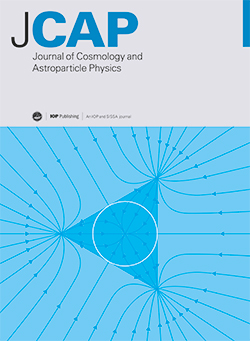On the capability of high redshift kSZ measurement with galaxy surveys
IF 5.3
2区 物理与天体物理
Q1 ASTRONOMY & ASTROPHYSICS
Journal of Cosmology and Astroparticle Physics
Pub Date : 2024-08-28
DOI:10.1088/1475-7516/2024/08/053
引用次数: 0
Abstract
The kinematic Sunyaev-Zel'dovich (kSZ) effect has been detected at z < 1 using various techniques and data sets. The ongoing and upcoming spectroscopic galaxy surveys such as DESI (Dark Energy Spectroscopic Instrument) and PFS (Prime Focus Spectrograph) will push the detection beyondz = 1, and therefore map the baryon distribution at high redshifts. Such detection can be achieved by both the kSZ stacking and tomography methods. While the two methods are theoretically equivalent, they differ significantly in the probed physics and scales, and required data sets. Taking the combination of PFS and ACT (Atacama Cosmology Telescope) as an example, we build mocks of kSZ and galaxies, quantify the kSZ detection S/N, and compare between the two methods. We segment the PFS galaxies into three redshift bins: 0.6 < z < 1.0, 1.0 < z < 1.6, and 1.6关于利用星系巡天测量高红移 kSZ 的能力
利用各种技术和数据集,已经在z<1时探测到了运动学上的Sunyaev-Zel'dovich(kSZ)效应。正在进行和即将进行的光谱星系巡天,如DESI(暗能量光谱仪)和PFS(Prime Focus光谱仪),将把探测范围扩大到z = 1以上,从而绘制出高红移下的重子分布图。这种探测可以通过 kSZ 堆叠法和层析成像法实现。虽然这两种方法在理论上是等价的,但它们在探测的物理和尺度以及所需的数据集上有很大不同。以 PFS 和 ACT(阿塔卡马宇宙学望远镜)的组合为例,我们建立了 kSZ 和星系的模拟模型,量化了 kSZ 的探测信噪比,并对两种方法进行了比较。我们把 PFS 星系分成三个红移区:0.6 < z < 1.0,1.0 < z < 1.6,1.6 < z < 2.4。这不仅是由于电子密度随着红移的增加而增加,还由于巡天体积增大,非线性降低,从而有利于在更高红移下进行速度重建。因此,与其他低红移的光谱巡天相比,PFS 巡天测量高红移 kSZ 效应的能力具有很大的优势。kSZ叠加的信噪比在很大程度上取决于从其他测光巡天中获得的星系群数量。但是一般来说,它的信噪比要低于kSZ层析成像,这主要是由于CMB仪器的噪声和星系群红移的误差造成的。下一代 CMB 勘测(如 CMB-S4 勘测)的特点是大大降低了仪器噪声,提高了角度分辨率,将其纳入 CMB-S4 勘测,有望把层析探测提高 10 倍,叠加探测提高 5 倍。这种未来的高信噪比探测不仅有望为重子的整体丰度提供精确的约束条件,还能为重子的分布提供新的视角。
本文章由计算机程序翻译,如有差异,请以英文原文为准。
求助全文
约1分钟内获得全文
求助全文
来源期刊

Journal of Cosmology and Astroparticle Physics
地学天文-天文与天体物理
CiteScore
10.20
自引率
23.40%
发文量
632
审稿时长
1 months
期刊介绍:
Journal of Cosmology and Astroparticle Physics (JCAP) encompasses theoretical, observational and experimental areas as well as computation and simulation. The journal covers the latest developments in the theory of all fundamental interactions and their cosmological implications (e.g. M-theory and cosmology, brane cosmology). JCAP''s coverage also includes topics such as formation, dynamics and clustering of galaxies, pre-galactic star formation, x-ray astronomy, radio astronomy, gravitational lensing, active galactic nuclei, intergalactic and interstellar matter.
联系我们:info@booksci.cn
Book学术提供免费学术资源搜索服务,方便国内外学者检索中英文文献。致力于提供最便捷和优质的服务体验。
Copyright © 2023 布克学术 All rights reserved.
京ICP备2023020795号-1
 京公网安备 11010802042870号
京公网安备 11010802042870号
京ICP备2023020795号-1

Book学术文献互助群
群 号:481959085

 求助内容:
求助内容: 应助结果提醒方式:
应助结果提醒方式:
